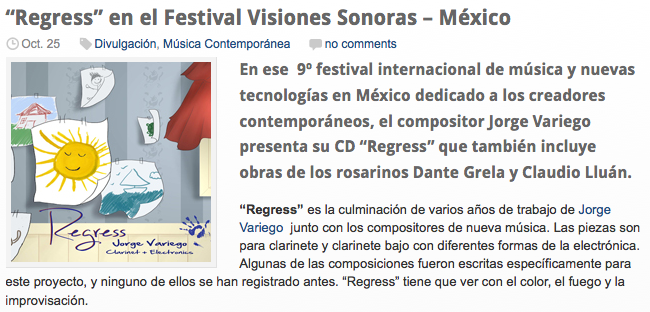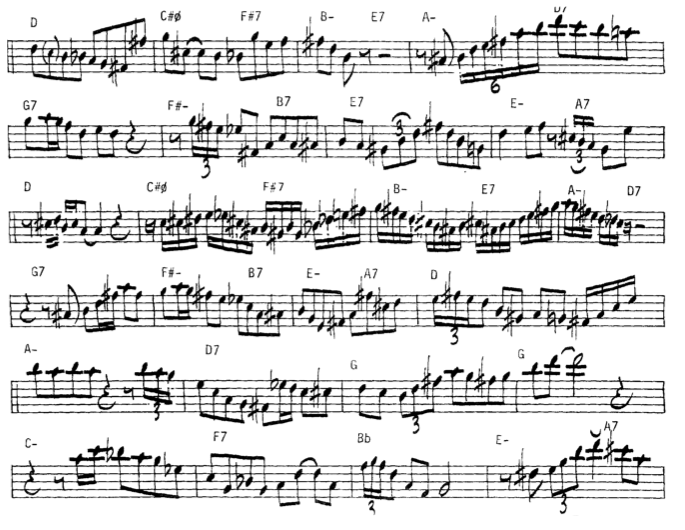Get the full arrangement here: A_child_is_born
Author Archives: admin
Ornet – meta jazz quartet LIVE!
8 channels + clarinet + video
The work proposes an interaction between the musical meta personalities of several artists, which are bound together by the live performer.
Entrenotas.com.ar
A new set of writings about music and technology
The last edition of “En el Límite” by the University of Lanús is available for download, very interesting articles here:
http://www.unla.edu.ar/public/en_el_Limite/archivo/enellimite_completo3.zip
Getting ready for Visiones Sonoras 2013!
¿Qué es Visiones Sonoras?
“Visiones Sonoras” es un festival que se ha consolidado como el principal evento en su tipo en México y uno de los principales en Latinoamérica. Se trata de un espacio para generar vínculos entre artistas y estudiantes, crear nuevos públicos y fomentar la creación de nuevas obras que integren el uso de las nuevas tecnologías. A través del encuentro de compositores, una serie de conferencias y talleres y los encargos a creadores mexicanos y extranjeros, este festival intenta contribuir a fomentar la creación sonora que incorpore el uso de las nuevas tecnologías de una manera que promueva la reflexión sobre las implicaciones del uso de estas herramientas en los procesos creativos de los artistas de hoy.
Site specific sound installation in Den Haag
Xenakis, Herma
Vitruvius’ resonant vases (addendum)
The term for ‘clarity’, claritas, is probably an equivalent for the Greek term lamprotēs, defined by Aristotle in De audibilibus, implying, besides distinctness, loudness and purity; and the context almost certainly implies a singing rather than a speaking voice. The function of the vases would have been to make some sounds louder than others, and to make them purer by stressing their fundamentals and suppressing their harmonics or overtones. The ‘series of notes which harmonize’ with the voice seems to refer to the fact that each vase would resonate and then re-radiate sound after the voice had ceased singing its fundamental note, so that if the concordant scale were sung, a number of the vases might be heard sounding together. In this way a kind of artificial reverberation time (estimated as 0·2–0·5 seconds) of particular quality would be produced in an open-air theatre that otherwise had none.
Besides bringing a reverberant response into the Greek theatre, it is possible that the acoustic jars helped an unaccompanied singer to keep to proper pitch for long periods. The vases resonating in various parts of the auditorium may also have served to disguise inferior musicianship by giving emphasis to musically important pitches. At the beginning of some early editions of Terence there is a short treatise in which the commentator, whose name is unknown, spoke of brass vases. He assigned to them the same use as Vitruvius […]
Bibliography
K. Harrison: ‘Vitruvius and Acoustic Jars in England during the Middle Ages’, Transactions of the Ancient Monuments Society, new ser., xv (1967–8), 49–58
C. Gilford: Acoustics for Radio and Television Studios (London, 1972)
CD review – I had to do it
BREATHLESS – KENNY G – ARISTA 07822-18646-2
Almost two decades ago, my girlfriend at the time came to me and said (I remember this literally) “I bought you a CD by this renowned clarinetist that I know you’ll love”. She gave me Breathless by Kenny G, and I immediately knew that it wouldn’t last much longer.
Breathless was the saxman’s sixth CD production, which became a music bestseller. The record travels the fine aesthetic line between pop music and smooth jazz, being neither of them. In Breathless, all the tunes combine the lightness of smooth jazz, with the predictability of pop. As a listener you always seem to know what is going to happen, and that is what eventually happens. The songs The joy of life, Forever in love, In the rain and Sentimental are shallow and unsurprising. Despite that, G does a technically acceptable job with the drums’ sequences, but while listening to the CD I started questioning the automatic playing of the sax. Was G just cruising through the melodies with his honey making single reed wand? This over abundance of well-known licks is unenchanting, and that is how it sounds: obvious and safe. Speaking of taking chances through a record, did you know that that same year (1992) Wynton Marsalis released Citi Movement, Joe Lovano Universal Language and Nirvana their Hormoaning?
However, I have to admit that the song G bop created some expectations (mainly for its title) which only lasted until I listened to it, nothing about bop, nor in the key of G, all about Kenneth Gorelick’s manufactured emotions. By the time this night is over could have been the least anticlimactic cut of the album. We heard Peabo Bryson’s lead voice in timeless versions of Disney movies’ songs. He is the one who sings along with Celine Dion in The beauty and the beast and in A whole new world, from Aladdin to name a few. Bryson’s participation couldn’t emerge from an ocean of commonalities. The song follows the recipe of every cloying love song, with extra cheesy saxophone fill-ins.
Needless to say, my relationship was over that night…
Uniform, interchangeable melodies in 4/4, almost at the same tempo, make a fair summary of this record. In the 20’s Eric Satie purposely wrote “furniture music” or ‘music not to be listened’, in the 90’s G wrote almost seventy minutes of it without even realizing. I can recommend this album; it is a must if you are fond of fungible music.
Disclaimer: this article was an “audition” review for a publication for which I work at the moment. Visit the Fanfare magazine archive to read my most recent work.
Algorithmic jazz?
Peek in real time
Charlie Markov: an algorithmic approach to the style of Charlie Parker
The Spanish version of this work will be published in the next edition of Sonic Ideas by the CMMAS, in Morelia, Mexico. Check it out!
Abstract
The present work is based on the hypothesis that the improvisational style of saxophonist Charlie Parker is condensed in the first chorus of his solo in his tune Confirmation. In order to verify this initial question, the study proposes a series of probabilistic analysis from the solo that are integrated in an algorithm in SuperCollider as a Markov chain of the first order.
Contact me if you want the full version of the paper. This research was presented at the North American Saxophone Alliance Conference in Minot State University in April.
Thank you!






